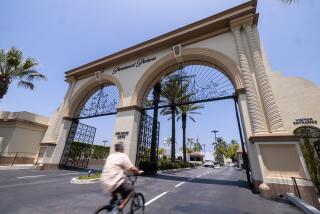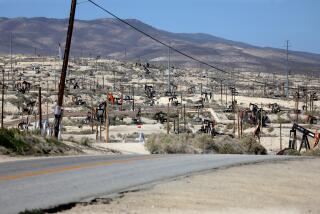Pacific Mutual Was Product of Frontier Era
- Share via
The names of the men who built the Pacific Mutual building in downtown Los Angeles were even more legendary than the landmark clock that adorned it for almost a century.
Heavy-duty empire builders and railroad tycoons Leland Stanford, Charles Crocker and Mark Hopkins--who lent their names to, among other things, a great university, a major bank and a grand hotel on San Francisco’s Nob Hill--did not really need another monument to their success. They just needed an insurance company that would pay swifter heed to the needs of life on the frontier.
The Pacific Mutual Life Insurance Co. was founded in 1868 by three of the merchants who became known as the Big Four after building the Central Pacific railroad, which later became the Southern Pacific. Tired of Eastern insurance companies’ slow payments on claims and their practice of charging Westerners an extra premium to cover the risks of frontier living, they opened the first life insurance company west of the Mississippi. It was headquartered in Sacramento and ultimately became the state’s largest life insurer.
Stanford, a former governor, soon-to-be U.S. senator and later founder of Stanford University, became the insurance company’s first president. A year later, he swung an unwieldy silver-headed sledgehammer toward a shiny golden spike (missing on the first swing) linking the Union Pacific with the Central Pacific near Promontory, Utah, thus opening the first transcontinental railroad. While Central Pacific moved ahead with its network of trains and steamships, holding the entire economy of the state in its monopolistic grip, growth at Pacific Mutual was relatively slow.
The insurance company’s first policy was reserved for Stanford. When he died unexpectedly during the Panic of 1893, his financial affairs were in a tangled state and the university, which was supported totally by his fortune, was unable to pay professors’ salaries. The future of the 2-year-old school was in doubt.
When Stanford’s Pacific Mutual policy paid his widow $11,784, she used it to help the university surmount its financial difficulties until her husband’s estate could be settled.
That same year, Pacific Mutual moved its headquarters to San Francisco and prospered. In 1906, it merged with the Conservative Life Insurance Co., which had been founded in Los Angeles six years earlier.
The decision was fortuitous. Several weeks after the deal closed, the company’s headquarters was dynamited in an effort to halt the spreading fire caused by the historic San Francisco earthquake.
Shaken administrators quickly moved south to Los Angeles, where they built a new headquarters at the corner of 6th and Olive streets, opening in 1908.
Designed by architects John Parkinson and Edwin Bergstrom, the stunning six-story, glazed-white structure resembled a Corinthian temple. It was built with one goal in mind: to create a fortress-like building that was earthquake-proof.
In 1922, a 12-story Beaux Arts commercial tower was added. Atop the entrance are two Greco-Roman figures standing alongside a cartouche emblazoned with a California redwood tree--Pacific Mutual’s symbol. Four years later, a two-story parking garage was added. Parkinson would later modernize the buildings.
Although problems started in 1918 when the company introduced an insurance product called the “non-cancelable disability income policy,” it wouldn’t be until the Great Depression that it would be brought to its knees.
The End of ‘Non-Can’ Policies
The idea of the policy was to provide coverage for temporary disabilities while prohibiting the company from canceling the policy, even if the policyholder became uninsurable.
But Pacific Mutual simply didn’t charge enough in premiums at first or vary its rates for different age groups. Nor did it have enough reserves as it continued to sell the popular policy throughout the Roaring ‘20s.
After the 1929 crash, many out-of-work policyholders began filing claims, citing illness caused by worry and frustration. Pacific Mutual began paying up to $4.1 million a year in disability benefits on the so-called non-can policies.
A 1936 state audit of the company revealed that future claims on these policies would be so substantial that further sales of “non-cans” would be “hazardous to all policyholders.”
The state seized the company and ordered its reorganization, even though all other lines of business were operating soundly.
In spite of its Depression-era problems, Pacific Mutual was soon wielding great influence again, due in part to its CEO, Asa V. Call, “Mr. Big” of state politics, a conservative kingmaker and one of the “millionaires’ group” that would later propel Ronald Reagan into the governorship.
The company paid off its last non-can policy in 1955 and completed its change to a mutual company in 1959.
Pacific Mutual stayed in Los Angeles until 1972, when it became one of the first major white-collar companies to set up headquarters in Orange County.
Although the company moved and its landmark clock and the glowing sign that read “Time to Insure” are gone, it left behind a monument that once held the offices of Laurel and Hardy Inc. and the law offices of Richard Nixon. And it left its initials--”P.M.L.I. Co.”--carved on the two newel posts in the 12-story architectural achievement that gave 6th Street beauty and dignity.
More to Read
Inside the business of entertainment
The Wide Shot brings you news, analysis and insights on everything from streaming wars to production — and what it all means for the future.
You may occasionally receive promotional content from the Los Angeles Times.










